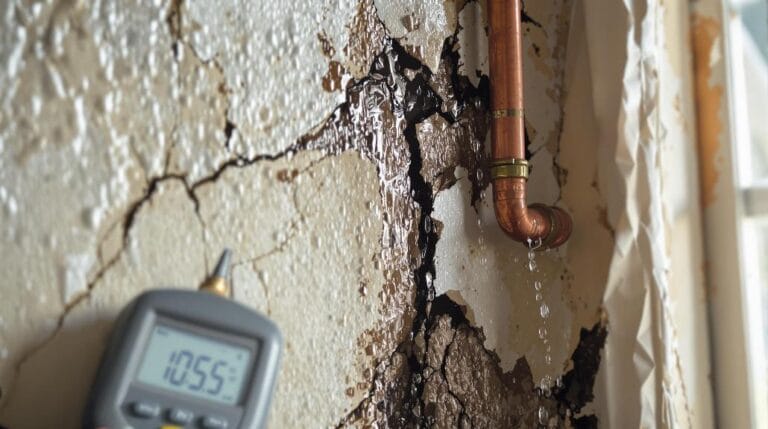Water damage can be devastating to your home, but understanding what qualifies for an insurance claim isn’t always straightforward. With water damage accounting for one-third of all home insurance claims in the UK, knowing exactly what’s covered – and what isn’t – is crucial for homeowners.
Whether you’re dealing with burst pipes, appliance leaks, or bathroom flooding, professional claims management services can be your ally in navigating these often complex claims successfully.
UK home insurance typically covers sudden water damage from burst pipes, appliance malfunctions, and accidental flooding caused by mishaps in the bathroom or kitchen.
A claims management service can assist by documenting evidence, coordinating with loss adjusters, and ensuring that claims are filed correctly.
Standard policies usually exclude gradual leaks and issues arising from wear and tear, making thorough documentation essential. Understanding the specifics of your policy and collaborating with professionals can significantly enhance claim outcomes in complex water damage situations.
Key Takeaways
- Sudden burst pipes, appliance malfunctions, and accidental flooding from bathroom fixtures typically qualify for home insurance claims in the UK.
- Claims management services assist in documenting damage through photographs, videos, and detailed inventories to strengthen the claim’s validity.
- Professional assistance ensures proper notification to insurers, guides emergency repairs, and helps prevent claim denials due to maintenance issues.
- Claims managers coordinate with loss adjusters, providing expert negotiation support and ensuring a fair settlement based on policy coverage.
- These services help identify coverage gaps, determine eligible damages, and maintain proper documentation throughout the claims process.
Common Types of Water Damage Covered by UK Home Insurance
While unexpected water damage can affect any home, UK insurance policies generally cover several common types of incidents that may leave properties waterlogged.
Among the most frequent claims are sudden damage from burst pipes—particularly during the winter months when freezing temperatures pose risks. Many policies also provide protection against accidental damage from malfunctioning appliances, such as washing machines and dishwashers.
Homeowners often find reassurance in knowing that common leaks from plumbing fixtures and unexpected roof damage during storms typically qualify for coverage. Sewer backups may also be included, depending on the specific terms of the policy.
What surprises many is that internal flooding caused by bathroom mishaps or kitchen disasters often falls under accidental damage extensions. Heavy rainfall can cause severe problems when it overwhelms drainage systems, leading to extensive property damage. The key factor is that these incidents must be sudden and unforeseen, rather than the result of gradual deterioration.
Related: Discover the common triggers of water damage
Understanding Your Policy: Coverage and Exclusions
Understanding a home insurance policy’s water damage coverage requires careful attention to both standard protections and optional add-ons that can significantly expand your safety net.
Most UK policies include basic coverage for sudden water damage from burst pipes, but homeowners should note critical exclusions like gradual leaks and wear-and-tear issues that could leave them financially exposed.
Standard policies also typically impose coverage limits and caps that vary by insurer, making it essential to review these details before disaster strikes.
Storm-related water damage often requires extensive documentation to demonstrate that roof leaks resulted directly from severe weather events rather than poor maintenance.
Standard Vs Optional Coverage
Before homeowners can make informed decisions about water damage protection, they must understand the key differences between standard and optional insurance coverage.
Standard policies typically cover sudden water damage from burst pipes and appliance failures. Most insurance providers include this basic protection in their standard water leak detection protocols to safeguard homes against unexpected disasters. Understanding your policy details is crucial since sudden and accidental damage receives different treatment than gradual issues.
Optional coverage offers enhanced protection that many homeowners find advantageous. This includes trace and access cover for locating hidden leaks, and accidental damage extension for DIY mishaps.
The insurance claims process becomes more comprehensive with these add-ons.
For complete peace of mind, consider supplementing standard coverage with optional features. While basic coverage addresses common scenarios, optional protection fills important gaps that could otherwise leave you exposed to significant expenses.
Key Policy Exclusions Explained
Insurance policies come with significant limitations that every homeowner should be aware of. Understanding these policy exclusions can help prevent unexpected challenges when making a claim in the future. Most standard policies do not cover gradual damage such as wear and tear, damp, or rot unless they result from a sudden incident.
Your insurance provider expects you to maintain your property properly. Regular maintenance of plumbing and appliances is not only good practice, but it is often a requirement for coverage. Neglecting these responsibilities could lead to denied claims. Professional services can help identify potential issues through thermal imaging investigations that detect hidden water damage.
Certain types of water damage require special attention. Surface water flooding may need additional coverage, whereas damage resulting from poor construction is typically excluded altogether.
It is important to remember that insurance terms can vary between providers, so it is essential to review your specific policy carefully.
Coverage Limits and Caps
Every standard home insurance policy sets specific limits on water damage claims – but do you know yours? Understanding your coverage limits is vital to avoid unexpected out-of-pocket expenses. Most policies cap water damage claims at predetermined amounts while offering policy enhancements for additional protection. Seeking guidance from insurance agents is recommended to fully understand coverage details.
| Coverage Type | Typical Limit | Common Exclusions |
|---|---|---|
| Burst Pipes | £100,000 | Gradual Leaks |
| Flood Damage | £50,000 | Groundwater |
| Emergency Repairs | £1,000 | DIY Fixes |
When claim disputes arise over coverage limits, having proper documentation is essential. Review your policy carefully to identify any gaps in coverage. Consider whether you need additional protection based on your property’s specific risks and value. Keep in mind that while standard policies cover sudden water damage, gradual issues often require specialised coverage options.
Essential Documentation for Filing Water Damage Claims
Preparing proper documentation is the cornerstone of a successful water damage claim. Insurance providers rely heavily on photographic evidence to assess the extent of damage and validate claims. A detailed inventory of affected items provides essential support for your case, helping to ensure fair compensation.
Key documentation should include repair records, correspondence with contractors, and professional assessments from plumbers. Keep all receipts for repairs and replacements to demonstrate the full financial impact.
Remember to capture clear images of both the source of the damage and its effects on your property.
Have you organised your documentation in a systematic way? Read our step-by-step guide to filing your claim.
The Role of Claims Management Services in Water Damage Assessment
Claims management services utilise advanced inspection methods such as infrared imaging and moisture mapping to accurately identify water damage patterns throughout a property.
Their expert documentation assists in building comprehensive claims files that detail every aspect of the damage using photographs, moisture readings, and detailed notes.
Professional assessors monitor and collect weekly meter readings to track the effectiveness of drying efforts and provide quantitative data for insurance claims.
Expert Inspection Methods
Professional water damage inspection requires sophisticated tools and methods to reveal both visible and hidden moisture problems in homes.
Modern moisture assessment techniques combine visual inspections with advanced technology to provide a comprehensive overview of water damage.
Experts rely on specialised equipment like moisture meters and infrared detection cameras to identify trouble spots that might escape the naked eye.
These tools can detect temperature differences and measure moisture content within walls, floors, and ceilings.
Early detection through these inspection methods helps prevent further deterioration and reduces overall repair expenses.
Hygrometers help assess ambient humidity levels that could contribute to ongoing issues.
The inspection process typically involves creating detailed moisture maps using specialised software.
This data helps restoration teams understand the full extent of the damage and develop targeted solutions that address both immediate concerns and potential long-term problems.
Claims Documentation Support
Once a thorough inspection reveals water damage in your home, the next step involves building a solid foundation of documentation for your insurance claim.
A detailed document retention strategy ensures you have all the evidence needed to support your case.
Key elements of proper evidence collection include:
- Detailed photographs and videos of all affected areas
- Comprehensive inventory of damaged items and possessions
- All receipts for emergency repairs and temporary accommodation
- Written records of conversations with insurers and contractors
- Timeline documentation of the incident and subsequent actions
Professional claims management services assist in organising and maintaining these essential records.
Their expertise ensures that nothing is overlooked in the documentation process, maximising your chances of a successful claim.
They understand what insurance companies look for and help present your case in the most persuasive manner.
Steps to Take Immediately After Discovering Water Damage
When water damage affects your home, taking fast and decisive action can mean the difference between a manageable cleanup and a costly disaster.
- The first immediate actions should focus on safety precautions: turn off the main water supply and disconnect electrical devices in affected areas to prevent electrocution risks.
- Next, locate the source of the leak through a thorough inspection of the affected area. While doing this, document everything with photographs and videos – this evidence will be vital for your insurance claim. Consider using wet-dry vacuums if water accumulation is minimal.
- Don’t forget to notify your insurance provider immediately about the incident.
- Remember to protect any undamaged belongings by moving them to a dry area.
Once these essential steps are complete, you can begin the process of removing standing water and drying out the space.
Learn More: Find out emergency steps to limit water damage
Preventive Measures and Their Impact on Insurance Claims
Preventing water damage requires far more than simply hoping for the best. Savvy homeowners implement preventive strategies that protect their property and enhance their insurance position.
Consider these essential measures that offer significant insurance benefits:
- Regular plumbing inspections to identify issues early
- Installation of leak detection devices for real-time monitoring
- Proper pipe insulation to guard against freezing conditions
- Routine maintenance checks on household appliances
- Thorough documentation of all maintenance activities
These proactive steps do more than just prevent water damage. They demonstrate responsibility to insurers and can lead to better claim outcomes. Given that water damage claims represent 26% of all domestic property insurance claims, prevention is a critical aspect of homeownership.
Many insurance providers view homeowners who take prevention seriously in a positive light. The result? Reduced claim frequencies, lower premiums, and fewer disputes when claims do arise.
Plus, you’ll have peace of mind knowing you’re effectively safeguarding your home.
Working With Loss Adjusters: What to Know
Even the most diligent preventive measures can’t guarantee that you will never face water damage. When water strikes your home, understanding the roles of loss adjusters becomes essential for successful claims negotiation. These professionals evaluate the damage, determine liability, and recommend settlement amounts.
| Key Aspects | What They Do | Your Response |
|---|---|---|
| Assessment | Document damage | Gather evidence |
| Evaluation | Review coverage | Know your policy |
| Resolution | Propose settlement | Negotiate terms |
Working with loss adjusters requires preparation and patience. While they represent the insurer’s interests, you can protect your own by maintaining detailed records and seeking independent advice when necessary. Remember that claims management services can advocate on your behalf, ensuring fair treatment and maximising your claim value through professional negotiations.
Legal Rights and Responsibilities in Water Damage Claims
Understanding your legal rights and responsibilities is fundamental to successfully navigating water damage claims in the UK. Both the rights of homeowners and the responsibilities of insurers are crucial in effectively managing the claims process.
When water damage occurs, homeowners must:
- Document all damage with photographs and videos promptly
- Take reasonable steps to prevent further damage
- Report the incident to their insurers without delay
- Keep records of all communications
- Maintain evidence of repair costs and expenses
Insurers are obliged to honour their policy commitments while adhering to established procedures for claim evaluation. They are required to process claims fairly and within reasonable timeframes.
It is important to remember that understanding policy exclusions is just as significant as knowing what is covered. Most policies cover sudden water damage but may exclude gradual deterioration or issues related to maintenance. Learn why water damage claims can be refused.
Maximising Your Claim Success With Professional Support
Successfully managing water damage claims often hinges on enlisting professional support at the right time. Effective claim strategies incorporate multiple layers of expert advocacy to ensure the best possible outcome.
Professional support begins with prompt documentation through photographs and detailed reports from leak detection specialists. Loss assessors play a vital role in negotiating fair settlements, while public adjusters serve as dedicated advocates throughout the claims process.
Understanding policy details and maintaining thorough communication records strengthens your position with insurers.
Have you considered how professional oversight could improve your claim’s success? By engaging qualified experts early in the process and following their guidance on documentation and repair procedures, homeowners significantly enhance their chances of receiving fair compensation for water damage.
Conclusion
When facing water damage in your home, knowing what qualifies for a claim is just the first step. While sudden incidents like burst pipes and appliance malfunctions are typically covered, the success of your claim often depends on how well it’s handled from the start. This is where professional claims management services prove invaluable – from proper documentation and timely notification to expert negotiation with loss adjusters.
Don’t let uncertainty about your coverage or the claims process prevent you from getting the settlement you deserve. With professional support, you can navigate the complexities of water damage claims confidently, ensuring every eligible aspect of your damage is properly assessed and compensated.



